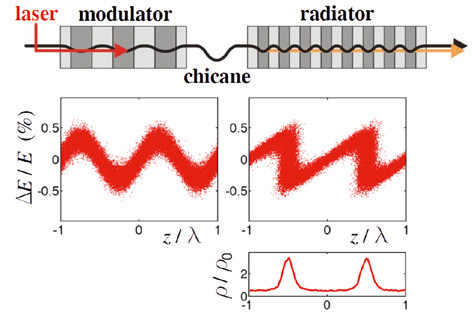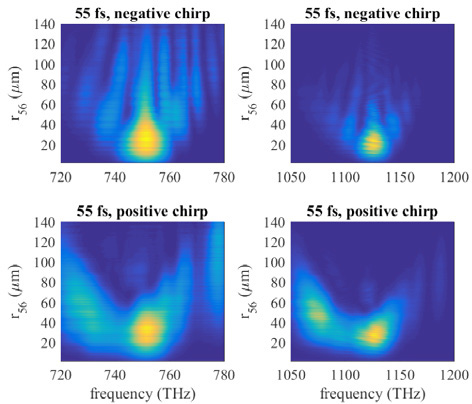Resources
 Part of the Oxford Instruments Group
Part of the Oxford Instruments Group
Expand
Collapse
 Part of the Oxford Instruments Group
Part of the Oxford Instruments Group
DELTA is a 1.5-GeV electron storage ring operated by the TU Dortmund University as a synchrotron light source and for research in accelerator physics. The pulse duration of synchrotron radiation is 100 ps (FWHM), given by the electron bunch length in the storage ring. In novel X-ray free-electron lasers (FELs), pulses as short as 10 fs are obtained, but to-date only eight of these single-user facilities are in operation while about 50 synchrotron light sources serve multiple users simultaneously. It is therefore worthwhile to investigate methods to extend the capabilities of conventional synchrotron light sources towards shorter pulse duration.
Coherent harmonic generation (CHG) is a method to generate coherent radiation pulses which are about 1000 times shorter than the electron bunch. Here, a femtosecond laser pulse co-propagates with the bunch through an undulator (the “modulator”, see Fig. 1), a magnetic structure with alternating field. The laserelectron interaction causes a periodic energy modulation within a thin “slice” at the center of the bunch. In a subsequent arrangement of dipole magnets (“chicane”) the energy-dependent path lengths of the electrons convert the energy modulation into a periodic variation of the charge density (“microbunching”). In a second undulator (the “radiator”), the microbunches give rise to the coherent emission of radiation at harmonics of the laser wavelength. These radiation pulses are as short as the energy-modulated slice but more intense than the incoherent radiation emitted by the rest of the electron bunch.

Figure 1: Principle of CHG with laser-induced energy modulation (ΔE/E versus longitudinal coordinate z in units of the laser wavelength λ) in an undulator (modulator), micro-bunching in a magnetic chicane, and coherent emission of laser harmonics in a second undulator (radiator) [4].
The CHG method was first demonstrated in 1984 at the storage ring ACO in France [1] and later applied at UVSOR in Japan [2] and Elettra in Italy [3]. Since 2011, CHG is tested and further developed at the DELTA short-pulse facility [4] shown in Fig. 2.

Figure 2: Short-pulse facility at DELTA comprising a laser system, the beamline BL 3 sending laser pulses to the undulator U250 (in modulator-chicane-radiator configuration), the diagnostics beamline BL 4, the soft-X-ray beamline BL 5 used for pump-probe experiments, and the terahertz beamline BL 5a [4].
Employing laser pulses from a Ti:sapphire system at 800 nm or frequency-doubled pulses at 400 nm, CHG radiation is studied at wavelengths ≥200 nm in air and ≥80 nm in an evacuated beamline. Since the repetition rate of the laser system is 1 kHz and the revolution frequency of a single bunch in the storage ring with 115.2 m circumference is 2.6 MHz, each CHG pulse is followed by about 2600 incoherent pulses and its detection requires either an intrinsically fast detector, such as a photodiode, or a gated device.
Similar to experiments at the seeded FEL facility FERMI@Elettra in Italy [5], the spectrotemporal properties of CHG radiation can be controlled by the chicane strength parameter r56 and the chirp of the laser pulses. To this end, CHG spectra were initially recorded using a Czerny-Turner-type monochromator followed by an avalanche photodiode. Mechanically rotating a grating to scan the relevant wavelength range took several minutes for each spectrum. After adding a fast-gated image-intensified CCD camera (iStar DH334T-18U-E3 from Andor Technology) with a minimum gate time of 2 ns [4], several CHG spectra could be recorded per second. This did not only shorten the measurement time by orders of magnitude and enabled fast parameter scans, but also allowed to record spectra of single CHG pulses. As an example, each plot in Fig. 3 shows 700 CHG spectra recorded within a few minutes while continuously increasing the chicane strength [7].

Figure 3: Spectra of CHG radiation around 400 nm (frequency 750 THz, left) and 266 nm (1128 THz, right) under variation of the chicane strength parameter r56 with negative laser chirp (top) and positive chirp (bottom) [7]. Each plot is composed of 700 spectra recorded by a fast-gated iCCD camera within a few minutes [6].
For a chicane strength below r56 ≈ 30 μm, the maximum energy modulation caused by the laser pulse center leads to the path length differences required for microbunching as shown in Fig. 1. Larger values of r56 cause “overbunching” of electrons at the laser pulse center and microbunching occurs in two consecutive regions with lower energy modulation, giving rise to a CHG double pulse. For an unchirped laser pulse, the temporal double structure leads to interference fringes in the CHG spectrum. This is shown in the top parts of Fig. 3, where the initial negative chirp compensates the positive chirp caused by the transition of the laser pulses through the vacuum window. On the other hand, positive chirp (bottom) adds to the chirp caused by the window. Thus, the two CHG sub-pulses differ in wavelength and the interference pattern vanishes. It is essential to understand these effects quantitatively in order to optimize CHG radiation for user applications.
Date: August 2018
Author: Prof. Dr. Shaukat Khan, Zentrum für Synchrotronstrahlung (DELTA)
Category: Application Note
